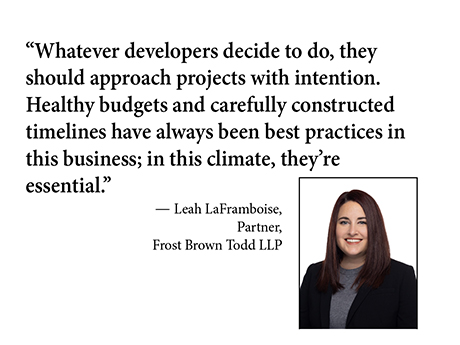By Leah LaFramboise, partner at Frost Brown Todd LLP
When COVID-19 became a global pandemic, commercial real estate developers saw unprecedented disruptions.
Materials became both more expensive and harder to come by. Even those developers that could source supplies had to reckon with labor shortages as workers sheltered at home. Construction projects had to be put on hold indefinitely to comply with new public health restrictions, ballooning budgets and timelines. What’s more, elevated interest rates — stemming from the turbulent economic landscape during the pandemic — made obtaining financing more expensive and difficult.
While lockdowns may be long over, the lasting effects of the pandemic and a more difficult financing environment are still posing challenges for developers. Fortunately, there are plenty of ways they can adapt.

A One-Two Punch
While the most dire construction material shortages during the pandemic have largely abated, many materials are still in short supply — and are much pricier. According to the National Association of Home Builders, for example, steel mill product prices are still 65 percent higher than pre-pandemic levels, while drywall is 42 percent more expensive than in 2020.
Commercial contractors, meanwhile, continue to face a significant worker shortage. Demand in key segments hasn’t bounced back either: office vacancy rates hit an all-time high earlier this year, thanks to the sticking power of remote work.
Additionally, many developers are still struggling to secure financing despite a slight easing of interest rates. It’s not only more expensive to borrow money, but more difficult as lenders undertake rigorous due diligence processes to ensure repayment. As commercial loans have hit their highest delinquency rates in nearly a decade, developers often need to provide much more detailed documentation, including site plans, to withstand this critical examination (and may still fall short even if they do).
Collectively, these challenges are shrinking the pool of developers as less-established businesses or those without regular injections of capital struggle to compete.
Adapt to Challenging Conditions
While there’s no one-size-fits-all solution to these issues, there are a number of options developers can explore to foster successful projects in today’s environment. Here are three best practices to keep top-of-mind.
Creative Financing
For those with sufficient flexibility in their corporate structure, pursuing alternative financing through private credit and private equity firms can be an easier way to obtain a loan compared to traditional banking. Private investors are typically more risk-tolerant and provide more individually tailored loans, though they may also come with higher leverage ratios, collateralization of additional assets or other more expensive, transaction-specific solutions. Developers should be aware and plan for the costs of working through lenders outside of the traditional banking world, including higher interest rates and late fees, and potentially more events of default with shorter cure periods.
Careful Project Selection
Many developers are already thinking differently about whether and how to pursue projects in a tough market, opting for safe bets. For instance, a large commercial office development that may have been attractive pre-COVID carries a much higher risk in a world where workers are used to working at home.
However, a mixed-use development that combines office, retail and entertainment uses, if planned correctly and in the right location, is much more attractive. It’s a wise approach — given the costs of materials and financing, it’s essential to ensure a financial cushion, a flexible timeline and the ultimate profitability of the property. In other words, this may not be the right time to take on untested projects. Rather than “if you build it, they will come,” developers should “build what they’re already there for” and look for reliable moneymakers.
Adapt to Changing Tenant Preferences
With record office vacancies and other asset classes adjusting to a post-COVID environment, tenants can afford to be choosier and demand all the bells and whistles, so developers should look for ways to add amenities and features that will keep properties occupied (and therefore profitable). Ultimately, this means being more flexible and creative, whether by revamping existing office buildings, pursuing unconventional uses for a space, bringing in more commercial tenants like bars and restaurants to serve office workers or opting for more mixed-use developments. The sooner developers accept that tenant preferences are unlikely to return to a pre-pandemic normal, the better.
Ultimately, whatever developers decide to do, they should approach projects with intention. Healthy budgets and carefully constructed timelines have always been best practices in this business; in this climate, they’re essential.
The impending change of administration in Washington is also fueling uncertainty. The incoming administration campaigned upon promises to change nearly every aspect of the way the country is governed, but it is unclear what specific changes will make it through a divided congress.
In the short term, this uncertainty may result in developer hesitance until the new administration begins to attempt to implement its agenda. As developers get more comfortable with what may and may not change under the second Trump administration, this hesitance should wane.


